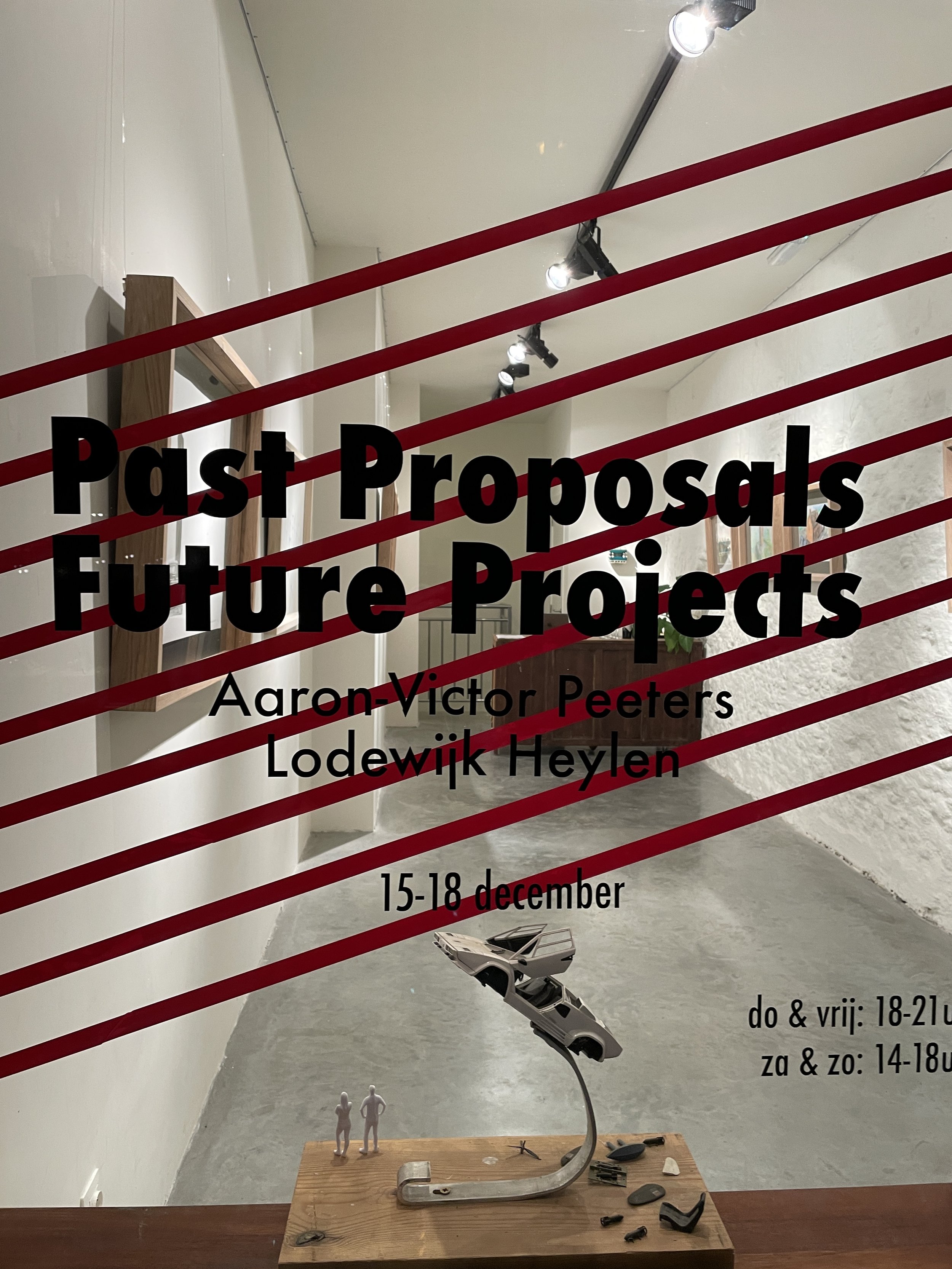
Past Proposals, Future Projects
Duo-exhibition with Aaron-Victor Peeters at Dingen Die Niet Verkopen art space in Antwerp
15-18 december 2022
For four days Aaron-Victor Peeters and Lodewijk Heylen presented a number of proposals for artworks in public space in the experimental art space Dingen Die Niet Verkopen (Things That Don't Sell), located in the heart of Antwerp. They are proposals they have made in the past for various locations or clients, but which have not yet been realized (or implemented). Don't expect large elaborated installations, but rather dreams on paper or in small scale models.
Sketches and maquettes are often considered as preliminary studies that lead to a finished artwork that we can admire in a museum, exhibition space, or even outdoors in public space. Rarely do they themselves get a prominent place in an exhibition. The exhibition Past Proposals, Future Projects highlights these preliminary studies.
On paper, anything is possible; your imagination knows no bounds. A maquette, however, must consider physical elements such as gravity to a greater extent. Artworks in a white cube can afford to do almost anything in terms of content, because they clearly bear the label 'art' and for that reason, the art object is both accepted and rendered "harmless". But those who want an artwork to function in public space must consider its complexity: the sometimes Kafkaesque regulations, the very diverse users of public space who each can interpret a work in their own way, and the thousands of other functions that prevail in public life such as traffic, housing, industry, or consumption. And we haven't even mentioned the high budgets needed to actually implement the concept. It's no wonder, then, that many art projects never get further than sheets of paper bursting with ambition.
The proposals of Heylen and Peeters do indeed have the desire to be executed, even if there is sometimes an impossibility inherent in them. This impossibility is expressed, for example, in rendering functional objects useless.
Peeters collects a whole arsenal of second-hand vehicles in his studio. He dismantles them and reassembles them, often rendering them unusable. In his proposals, for instance, we see two cars mounted on top of each other with the wheels facing each other. The mechanism works, the wheels turn, but you won't be able to drive anywhere. In another proposal, he replaces the wheels with four heavy concrete spheres that render the vehicle immobile, no matter how powerful the engine runs. There's a sort of nostalgia in his work for a time when cars still symbolized the pinnacle of freedom, independence, speed, and progress. In some sketches, he also attaches cut-out pit babes, voluptuous women in revealing clothing. Because beside every successful man with a flashy car, wasn't there always a pit babe? Unfortunately, these ladies did not survive the zeitgeist, and Peeters' work seems to suggest that the era of the automotive industry is almost over. Just like monoliths, pick-up trucks will soon remind us of a fascinating past whose artifacts' meanings are no longer clear. He gladly bids farewell to our fossil vehicles in a special sketch where he proposes an dismantled car on a litter. The car is carried like a relic by strong arms from the community in a procession and then disappears again into a sacred shrine or temple. The functionality of the car that once helped us move forward in life is forever gone. Peeters' works express an indistinct nostalgia for a past that is not yet entirely concluded and therefore not yet fully comprehensible. The Portuguese would use the bittersweet word "saudade" for it.
That feeling also applies to Heylen's Reenactments. He proposes the reenactment of events that have not yet occurred. His proposals are a contradiction in terms in multiple meanings. The linearity of the concept of "time" makes it impossible to reconstruct an action that has not yet happened, simply because you cannot yet know if and how it will occur. Moreover, the proposed Reenactments are of such a destructive nature that replaying them would lead to irreparable damage. For example, he proposes a Reenactment of the demolition of the viaduct in Merksem. This bridge will likely disappear without much ceremony during the Oosterweel works, which will significantly affect traffic in and around Antwerp. By already proposing a reenactment of its demolition, Heylen elevates the (future) event and places it on a pedestal. Reenactments traditionally only take place for important historical moments like the Battle of Waterloo, milestones that are etched in our collective memory and that we find valuable enough to commemorate. Heylen's proposal is, in advance, a warm call not to forget this milestone either. Other Reenactment proposals also carry this impossibility within them. For instance, he suggests the destruction of a house by building it on different trailers of trucks and then driving them in different directions, causing the foundations to crack and the house to collapse. Or a reconstruction of a flood in a city center by constructing an enclosed dike and filling it with water. In other sketches, Heylen wants to place a crane upside down on its boom or set concrete slabs upright on a road surface to create a vertical lane. In all cases, it is impossible to repeat the action because the object and the environment will look completely different, broken, or even completely destroyed. The proposals make us aware that what we take for granted is not the only option.
Due to the high priority we give to the utilitarian in our society, there seems to be no place to actually implement these absurd proposals by Peeters and Heylen. Nevertheless, each of these is a very interesting thought exercise. How will we shape our future? What is already absurd and endangered without us realizing it? By bringing their preliminary studies into the open, they make their thought processes visible and invite us to think along about how we want to see, use, organize, and above all, experience our shared space.
Laureline Soubry
December 2022






